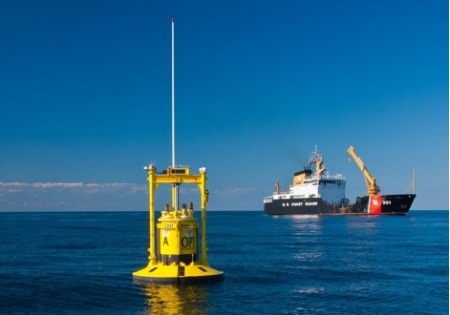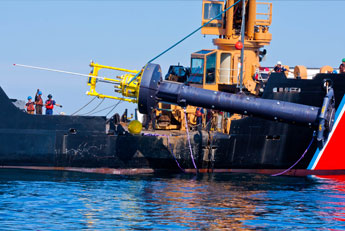Remember when Ocean Power Technologies (OPT) deployed its autonomous PowerBuoy wave power generator off the coast of New Jersey last year? Well, according to OPT, the results are in, and the PowerBuoy has performed beyond its specifications, in a wide range of sea conditions—from dead-calm waters to hurricanes.
The PowerBuoy was commissioned as part of the U.S. Navy’s Littoral Expeditionary Autonomous PowerBuoy (LEAP) program. Historically, the U.S. Coast Guard and U.S Navy have fueled their offshore radar and communications systems with diesel generators. But these power sources require frequent maintenance and refueling at sea. In 2010, LEAP awarded OPT $2.75 million to develop an alternative power supply for maritime security and monitoring equipment.

The resulting LEAP PowerBuoy is smaller and more compact than OPT’s standard utility PowerBuoy, which has been deployed in Scotland and Hawaii (and is the centerpiece to the company’s big plans off the Oregon coast). It also includes an on-board energy storage system to provide reliable off-grid power in remote ocean locations.
Project specifications called for the PowerBuoy to deliver a continuous 150 watts; but OPT says the actual results exceeded their expectations. In addition to surviving Hurricane Irene, the PowerBuoy supplied a continuous 400 watts throughout its entire deployment, with a peak power delivery of 1,500 watts. Even during extended periods of zero wave activity, the PowerBuoy’s on-board power management and storage system enabled it to continue to supply constant power. And although it has only been deployed for six months at this point, the system has been engineered to require no maintenance for three years.
“The unique [autonomous PowerBuoy’s] ability to supply persistent levels of power, with no routine maintenance requirements and in extended no-wave periods, represents an entirely new offering for satisfying offshore power needs,” said Charles F. Dunleavy, chief executive officer of OPT. “We believe these results establish baseline capabilities for our autonomous product line in support of maritime security applications as well as other applications in markets such as the offshore oil and gas industry, the oceanography community and aquaculture sector. We are proud to be a part of this program for national security and are grateful for the support of the US Navy.”
Although the LEAP PowerBuoy was probably not subjected to the same rigorous environmental impact assessments as the much larger SeaGen in Northern Ireland, these successful field trials are demonstrating that wave and tidal generators are becoming increasingly more viable.

The U.S. Department of Energy recently released a report showing that U.S. wave and tidal resources (in combination with hydropower and other water power resources) could contribute as much as 15 percent of the nation’s electricity by 2030.
But, unlike the U.K., the U.S. has yet to effectively harness its offshore resources. OPT and Ocean Renewable Power have been leading this effort, with projects off the coast of Oregon and in the Bay of Fundy, both in American and Canadian waters. Alaska is also thought to have a wealth of tidal resources. But the title for first commercial marine energy park in the U.S. is still up for grabs.